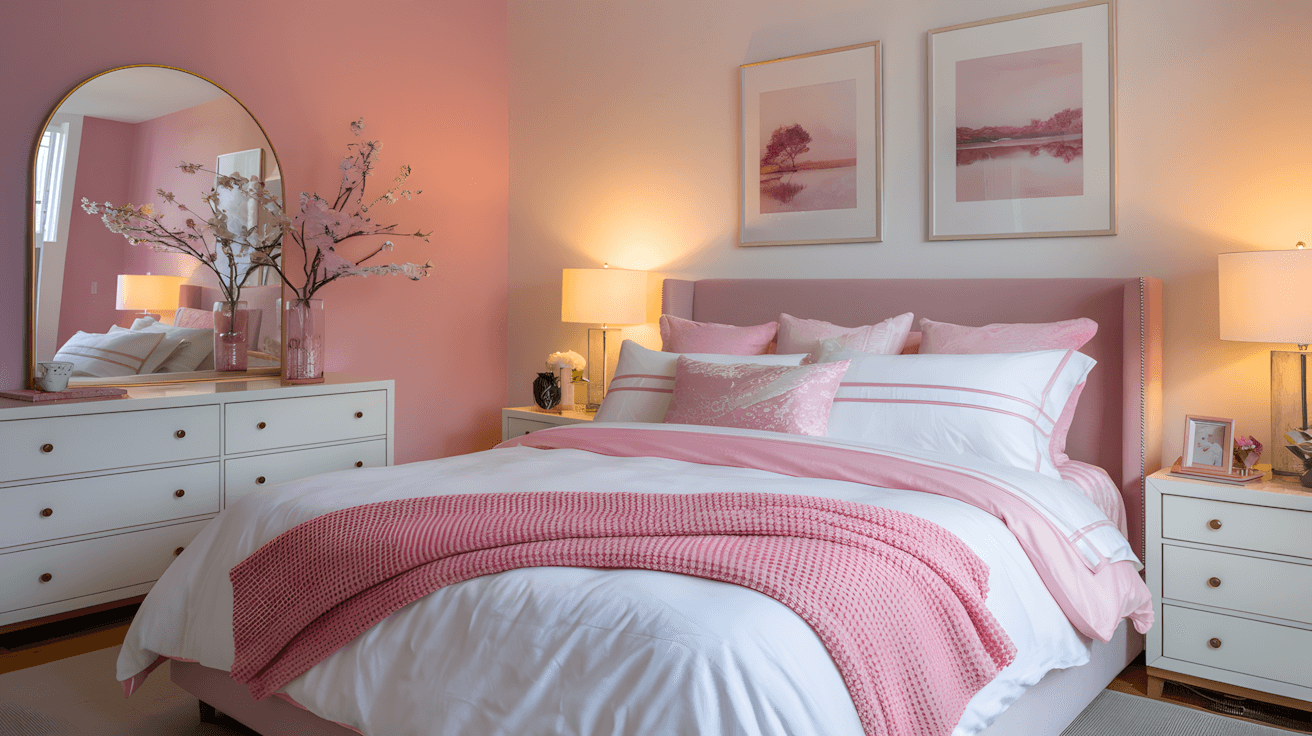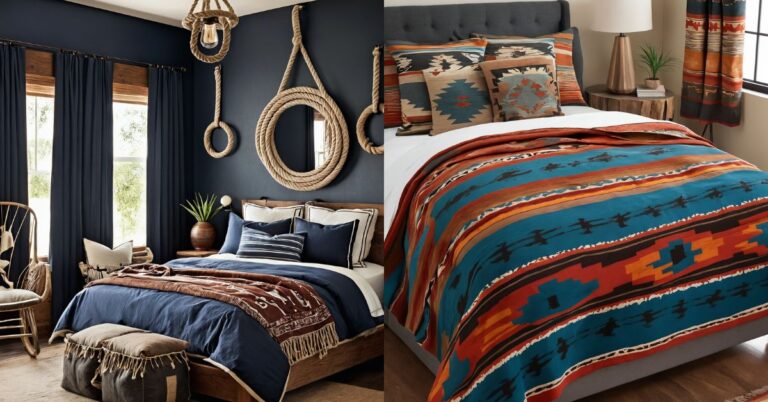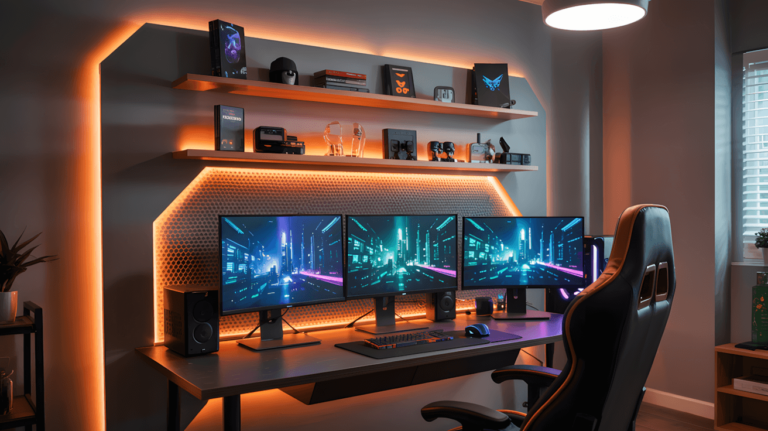After designing bedrooms for homeowners with varying sleep needs, lifestyle demands, and maintenance preferences, I’ve discovered that creating a truly restful bedroom requires balancing aesthetic appeal with sleep science, practical functionality, and long-term sustainability.
Many beautiful bedroom designs fail to provide the restful environment that bedrooms are fundamentally meant to create.
From my experience working with families on bedroom renovations, I’ve learned which trendy décor elements photograph beautifully but disrupt sleep quality, and which thoughtful design choices genuinely enhance both rest and daily well-being.
These 25 bedroom ideas represent solutions that successfully combine visual appeal with sleep-supportive functionality.
Understanding Sleep-Supportive Bedroom Design
A bedroom serves one primary purpose: facilitating quality sleep and rest. While aesthetic appeal matters for psychological well-being, all design choices should support rather than compromise sleep quality.
The most successful bedroom designs excel in creating environments that promote relaxation, reduce stress, and support healthy sleep patterns while reflecting personal style and preferences.
Natural Material Foundations
1. Wooden Accent Sleep Sanctuary

This natural material approach demonstrates how authentic wood elements can create both visual warmth and psychological comfort essential for rest.
Key Sleep-Supportive Elements:
- Wooden bed frame for natural material connection – provides psychological comfort while offering durability and chemical-free sleeping environment
- Neutral bedding for visual calm – reduces stimulation that can interfere with relaxation and sleep preparation
- Soft ambient lighting for circadian rhythm support – provides gentle illumination that doesn’t disrupt natural melatonin production
- Botanical artwork for stress reduction – incorporates nature imagery proven to lower stress hormones
Material benefits: Natural wood releases fewer volatile organic compounds than synthetic materials, supporting better air quality for sleep.
2. Contemporary Warmth with Light Management
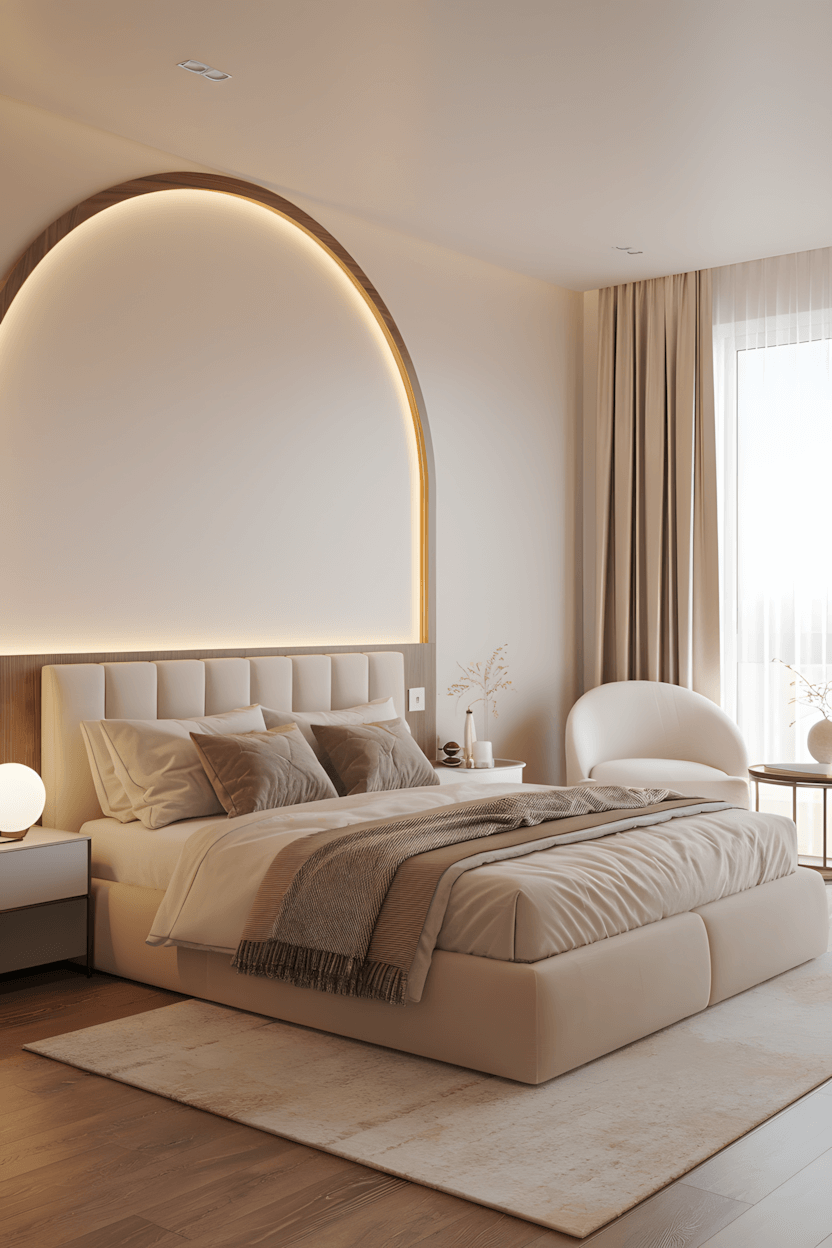
This lighting-focused approach shows how illumination design can significantly impact sleep quality and bedroom functionality.
Key Sleep-Supportive Elements:
- Beige color palette for psychological calm – uses neutral tones that promote relaxation without overstimulation
- Wooden arch with warm lighting – creates architectural interest while providing adjustable illumination for evening routines
- Minimalist furniture for reduced visual clutter – eliminates distractions that can interfere with mental relaxation
- Strategic lighting placement – positions light sources to avoid disrupting sleep while supporting bedtime activities
Light therapy: Warm-toned evening lighting supports natural circadian rhythms by avoiding blue light that suppresses melatonin.
3. Neutral Foundation with Texture Variety

This comfort-focused approach demonstrates how texture can enhance physical and psychological comfort without compromising sleep quality.
Key Sleep-Supportive Elements:
- Textured bedding for tactile comfort – provides sensory satisfaction that supports relaxation without being overstimulating
- Wooden panel backlighting for ambient illumination – creates gentle lighting that can be dimmed for sleep preparation
- Patterned rug for visual grounding – adds interest while maintaining the calm color palette essential for rest
- Circular pendant for soft overhead lighting – provides general illumination without harsh shadows or glare
Texture strategy: Varied textures in neutral colors provide sensory interest without the stimulation that can interfere with sleep preparation.
Nature-Inspired Calm Environments
4. Mountain Landscape Sleep Environment
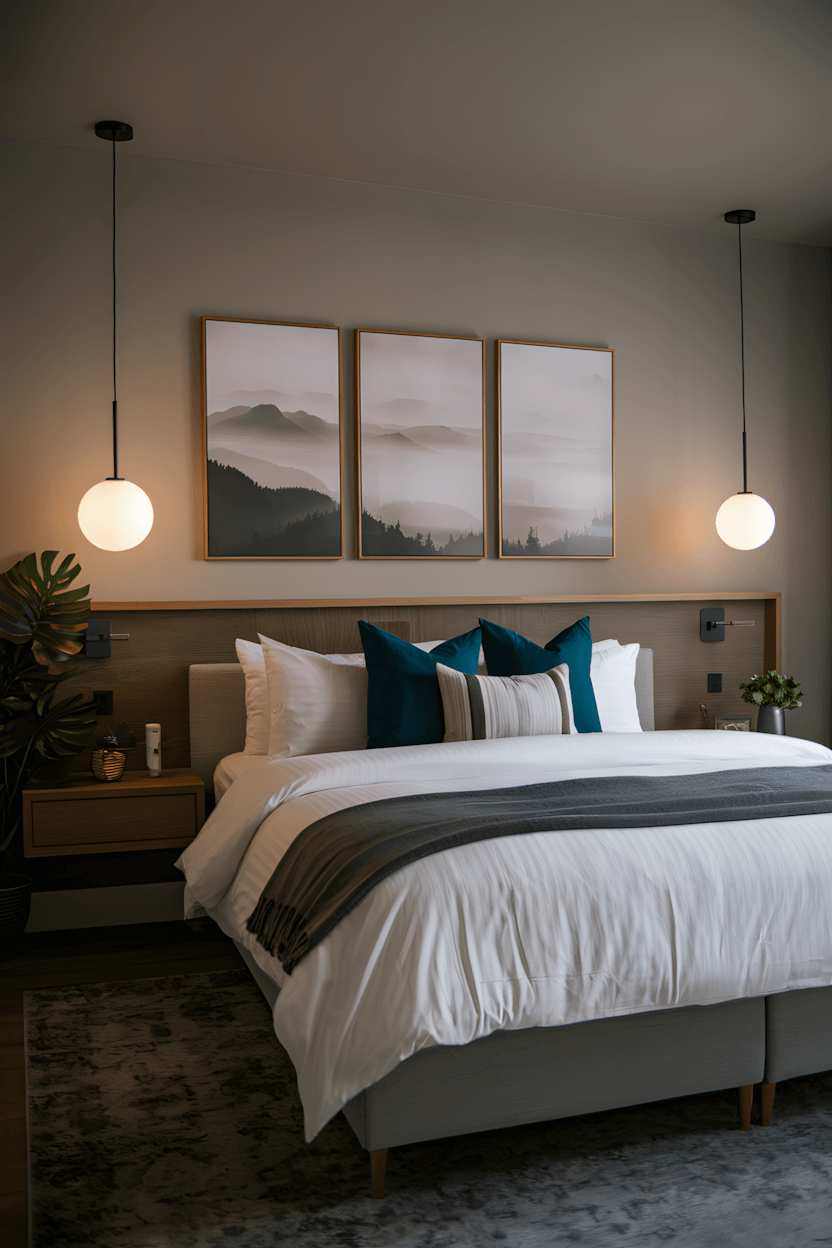
This nature-themed approach shows how landscape imagery can create psychological calm essential for quality rest.
Key Sleep-Supportive Elements:
- Dark teal for sophisticated calm – uses color psychology to create restful environment that supports deep sleep
- Mountain landscape artwork for stress reduction – incorporates nature imagery that psychologically reduces stress and anxiety
- Wooden accents for natural connection – maintains biophilic elements that support mental well-being
- Spherical lighting for gentle illumination – provides soft light that doesn’t create harsh shadows or interfere with relaxation
Nature psychology: Landscape imagery in bedrooms has been shown to reduce stress hormones and improve sleep onset time.
5. Minimalist Natural Integration
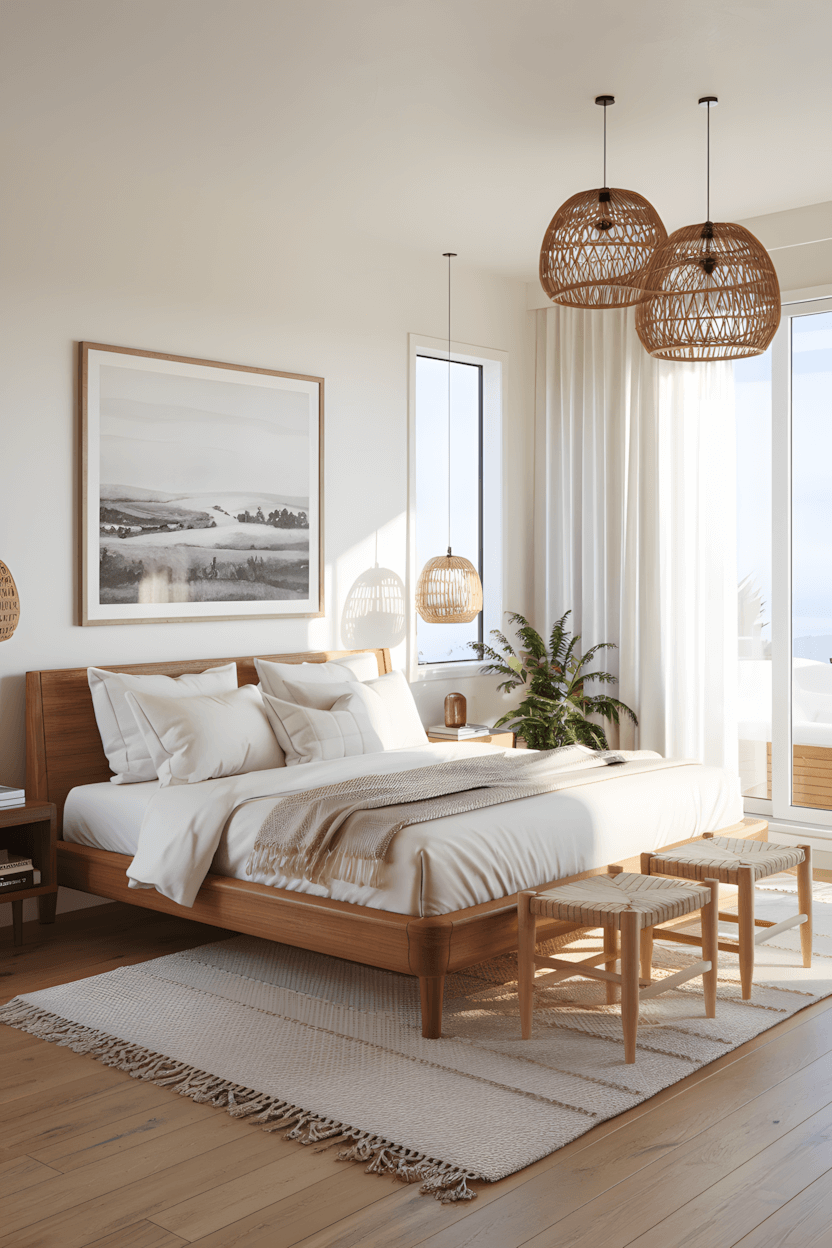
This uncluttered approach demonstrates how minimalism can enhance sleep quality by reducing environmental stressors.
Key Sleep-Supportive Elements:
- Woven pendant lights for natural material connection – uses organic materials that provide visual warmth without chemicals
- Monochromatic palette for visual rest – eliminates color stimulation that can interfere with mental relaxation
- Natural wood furniture for authentic comfort – provides chemical-free surfaces and natural tactile comfort
- Landscape artwork for psychological calm – incorporates nature elements that support stress reduction
Minimalist benefits: Reduced visual clutter decreases mental stimulation and supports the psychological transition to sleep.
6. Rustic Green Sleep Retreat
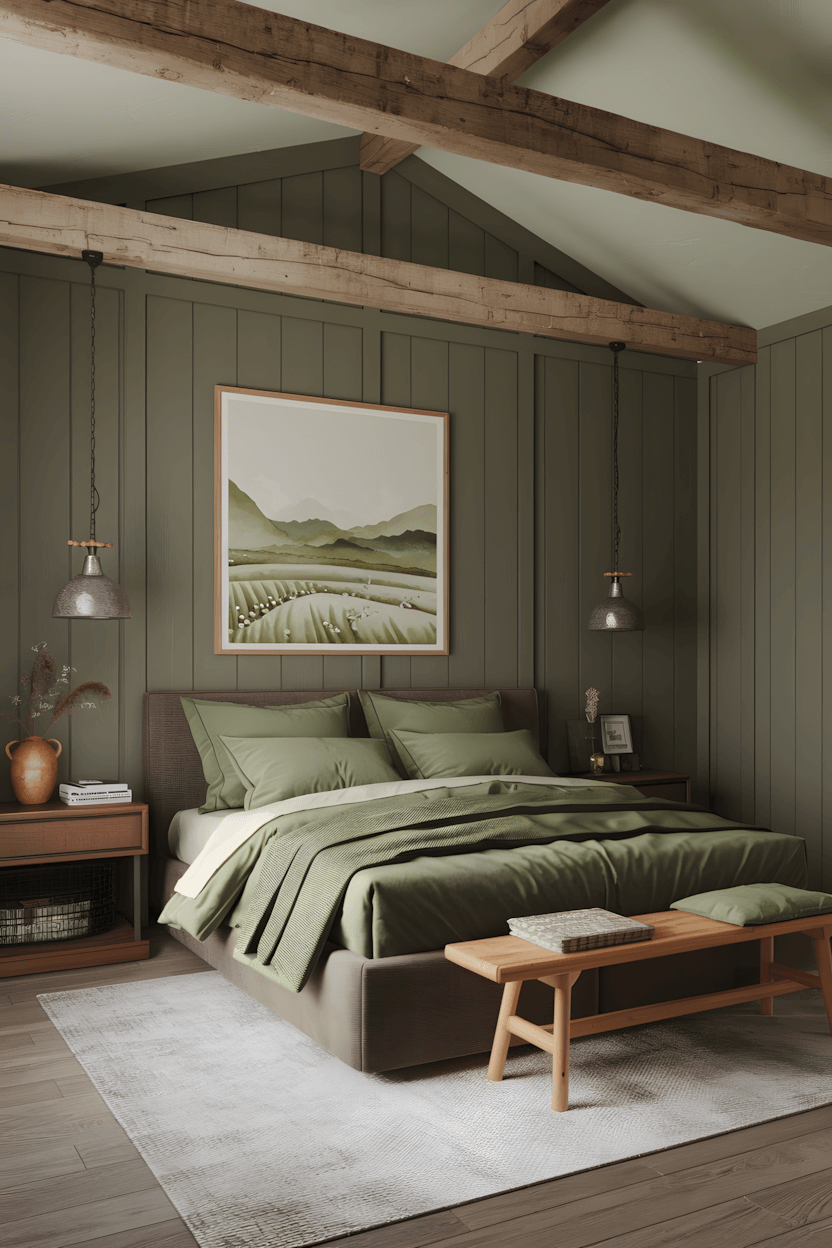
This earth-tone approach shows how deeper colors can create cocoon-like environments that enhance sleep quality.
Key Sleep-Supportive Elements:
- Deep green paneling for psychological security – creates enveloping environment that supports feelings of safety and comfort
- Coordinated bedding for visual harmony – maintains color consistency that reduces visual stimulation
- Wooden beams for natural warmth – adds authentic architectural interest while maintaining natural material benefits
- Landscape artwork for nature connection – provides visual connection to calming natural environments
Color psychology: Deep green tones are associated with rest and renewal, making them ideal for sleep environments.
Urban and Contemporary Approaches
7. Urban Sophistication with Sleep Optimization
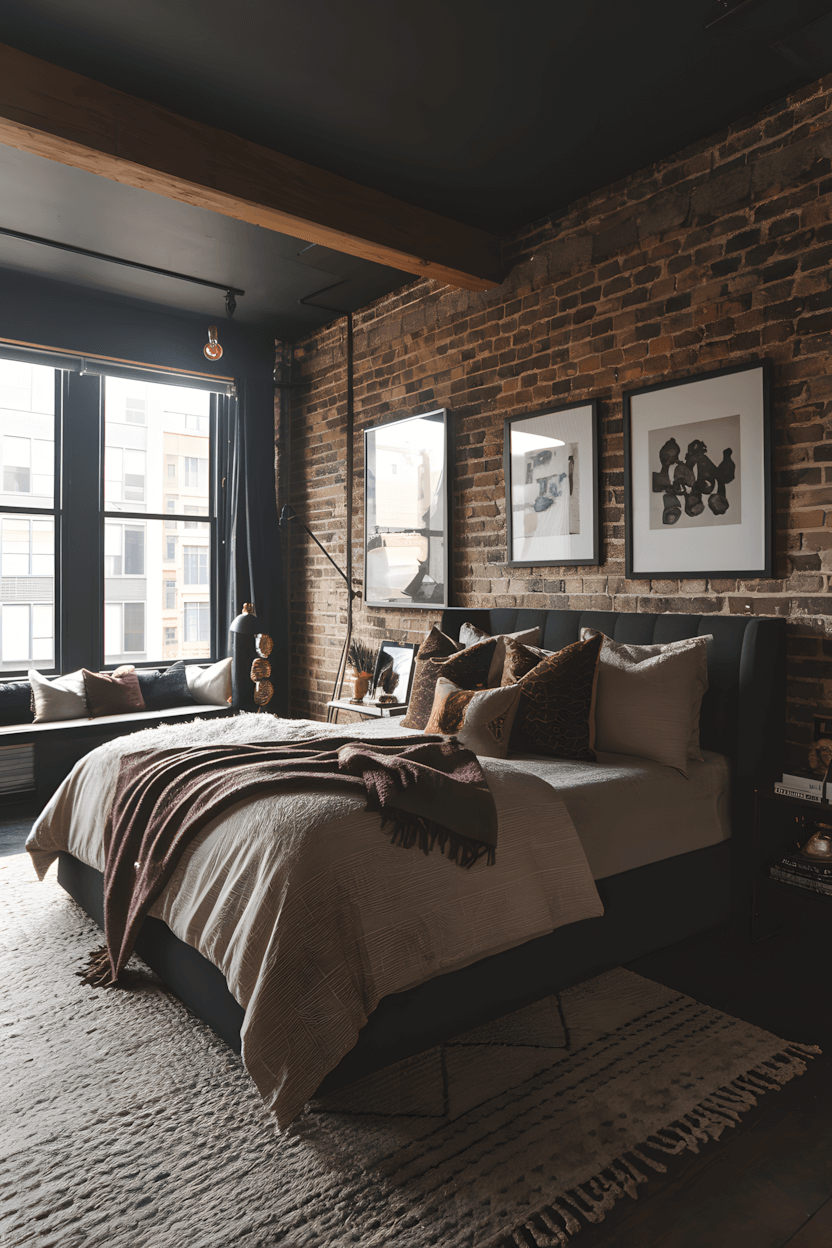
This city-inspired approach demonstrates how urban aesthetics can be adapted to support quality rest.
Key Sleep-Supportive Elements:
- Dark color palette for light control – reduces visual stimulation while creating sophisticated atmosphere
- Exposed brick for authentic texture – provides natural material benefits without chemicals or off-gassing
- Wooden ceiling elements for warmth – balances hard urban materials with natural comfort
- Large windows with light control options – allows natural light during day while providing darkness for sleep
Urban adaptation: City bedrooms require careful attention to light and noise control while maintaining aesthetic appeal.
8. Luxury Tropical with Calming Elements
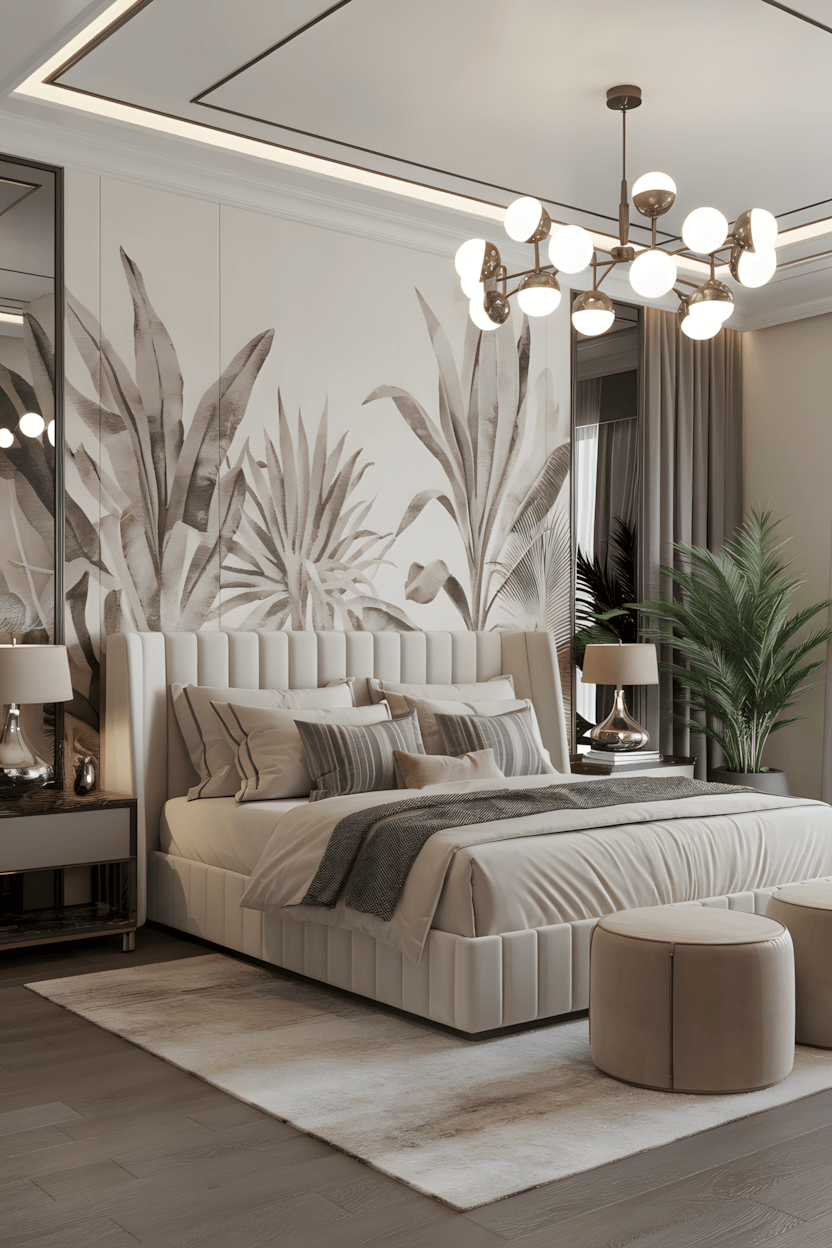
This resort-inspired approach shows how luxury elements can enhance rather than compromise sleep quality.
Key Sleep-Supportive Elements:
- Neutral luxury bedding for comfort – provides high-quality materials that support temperature regulation and comfort
- Tropical mural for stress reduction – incorporates calming nature imagery that supports psychological relaxation
- Modern chandelier with dimming capability – provides elegant lighting that can be adjusted for sleep preparation
- Quality furnishings for long-term comfort – invests in pieces that provide lasting comfort and satisfaction
Luxury sleep: Quality materials and finishes often provide better sleep support through improved comfort and durability.
Elegant and Sophisticated Solutions
9. Tufted Elegance with Light Control
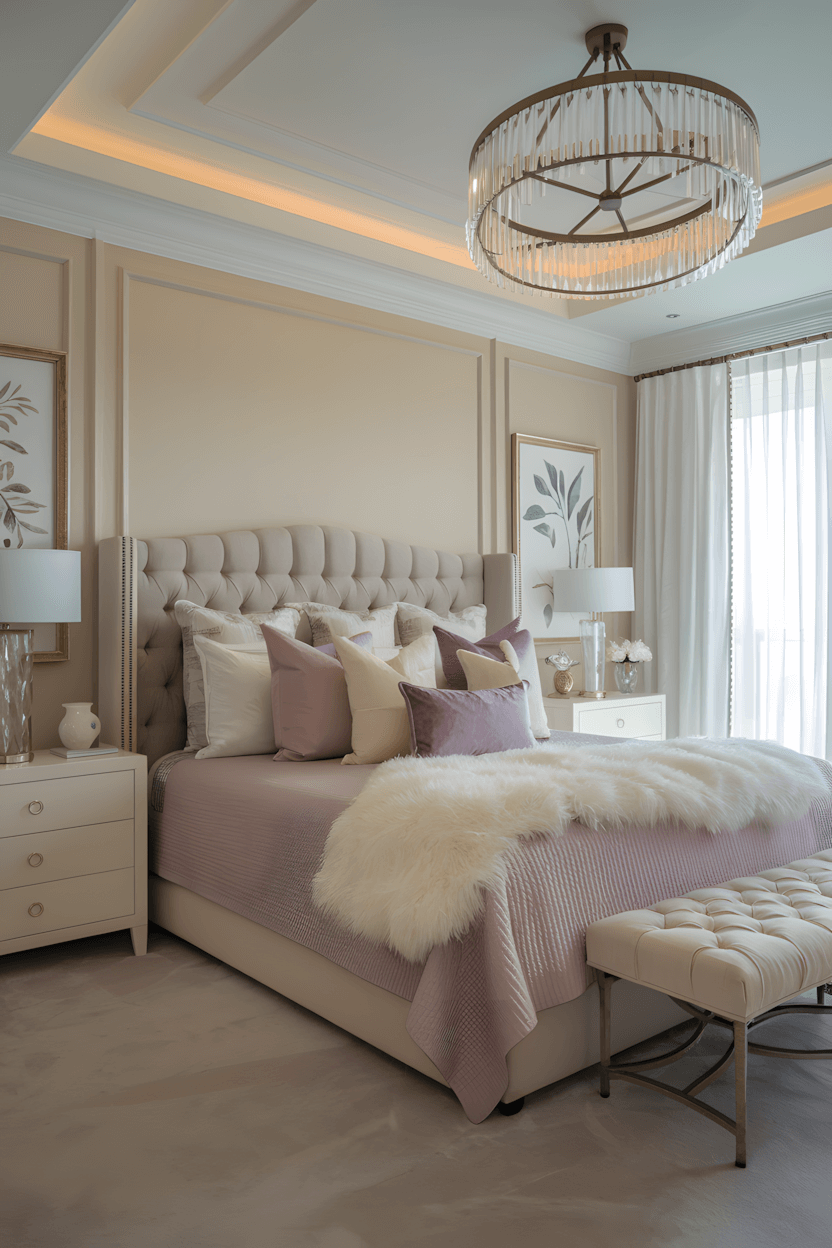
This classical approach demonstrates how traditional elegance can support modern sleep science requirements.
Key Sleep-Supportive Elements:
- Tufted headboard for reading comfort – provides proper back support for bedtime reading while adding visual elegance
- Crystal chandelier with dimming – offers beautiful lighting that can be adjusted to support circadian rhythms
- Botanical artwork for nature connection – incorporates calming natural elements that support stress reduction
- Sheer curtains for light management – allows natural light control essential for quality sleep
Classical comfort: Traditional comfort elements often provide better long-term satisfaction than trendy alternatives.
10. Backlit Wood with Modern Functionality
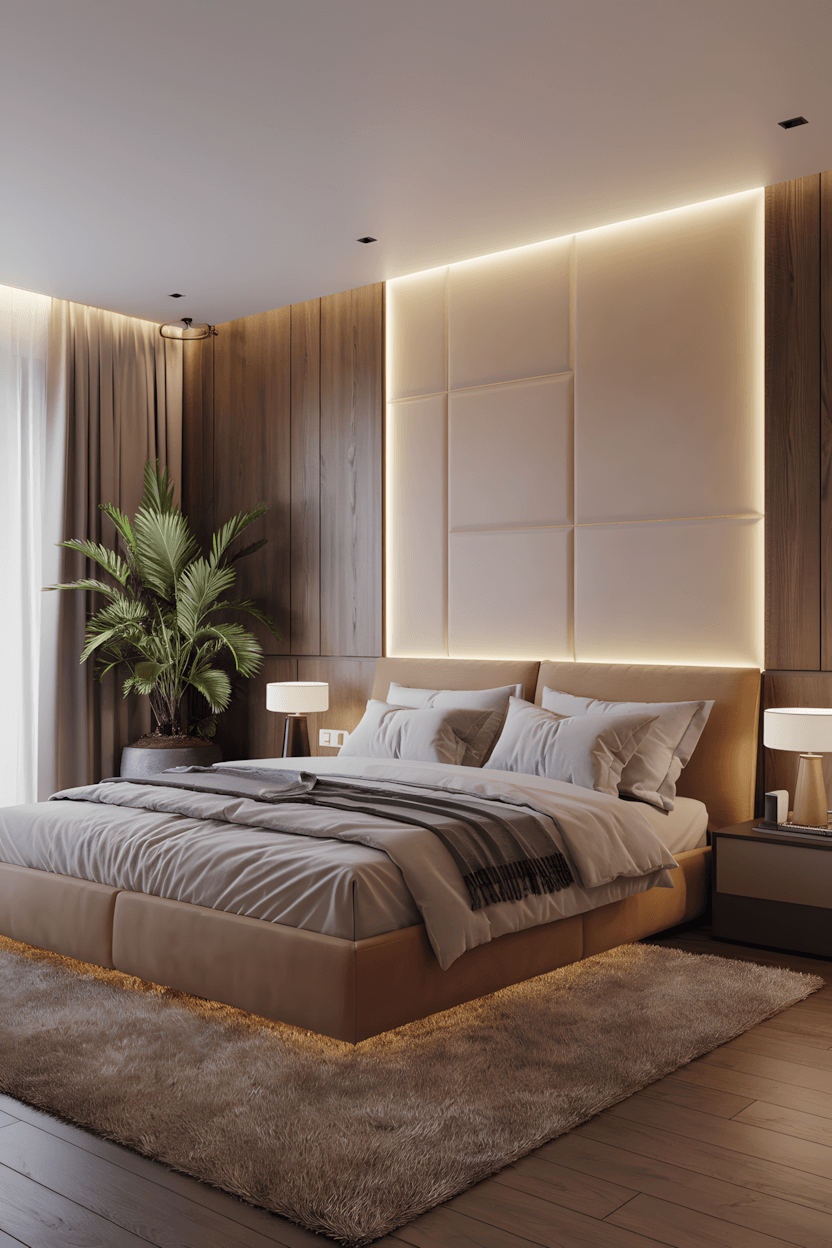
This contemporary approach shows how modern technology can enhance rather than compromise bedroom tranquility.
Key Sleep-Supportive Elements:
- Backlit wooden panel for ambient lighting – provides gentle illumination that supports evening routines without disrupting sleep
- Neutral bedding for visual calm – maintains restful color palette essential for psychological relaxation
- Plant integration for air quality – improves bedroom air quality while providing natural beauty
- Earthy tones for psychological grounding – uses colors that support feelings of stability and calm
Technology integration: Modern lighting technology can support sleep quality when designed thoughtfully.
Bold Color with Sleep Consideration
11. Dark Blue Sophistication
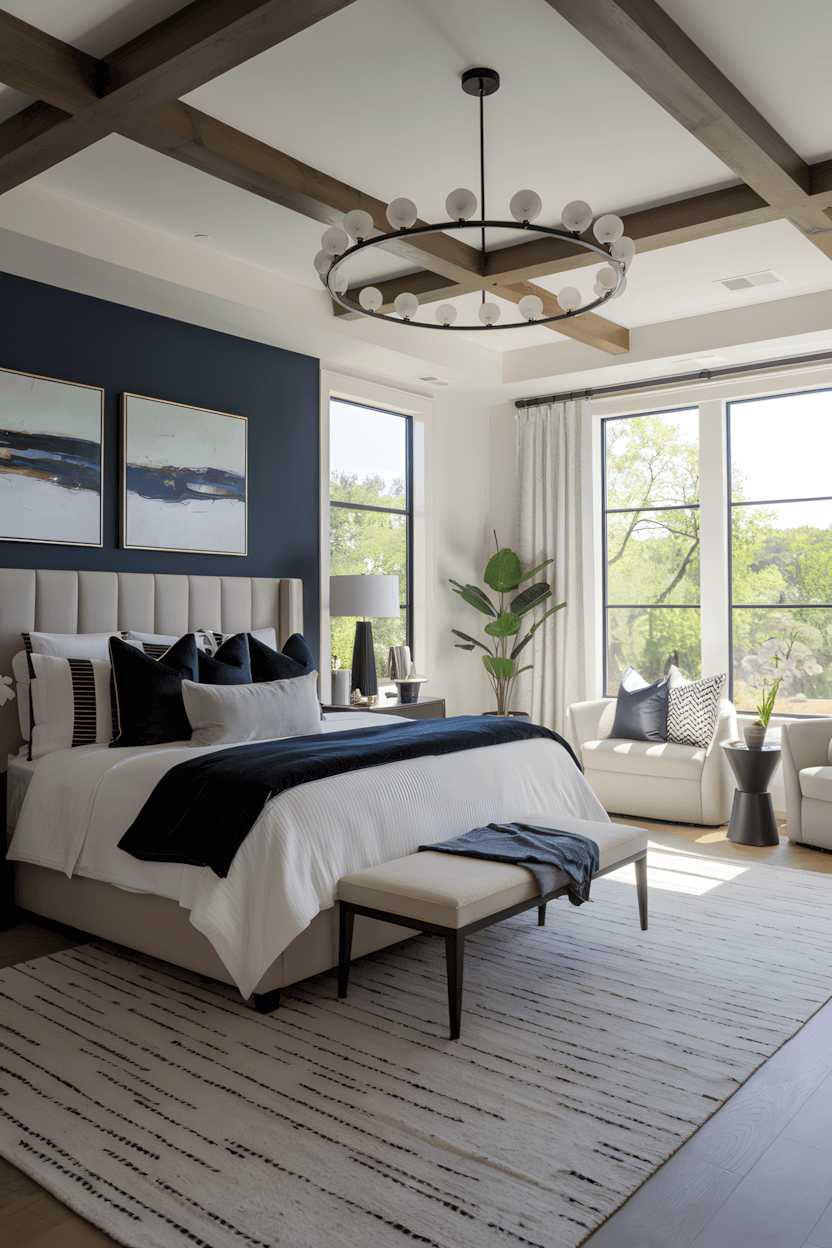
This dramatic approach demonstrates how bold colors can create restful environments when used thoughtfully.
Key Sleep-Supportive Elements:
- Dark blue walls for sleep-conducive darkness – creates naturally dark environment that supports melatonin production
- White bedding for contrast and cleanliness – provides visual brightness while maintaining clean, fresh appearance
- Modern chandelier with adjustable lighting – ensures adequate illumination for activities while supporting sleep preparation
- Seating area for bedroom functionality – provides space for relaxation activities that support bedtime routines
Dark color benefits: Dark bedroom walls can improve sleep quality by creating naturally darker environments.
12. Organic Modern with Natural Elements
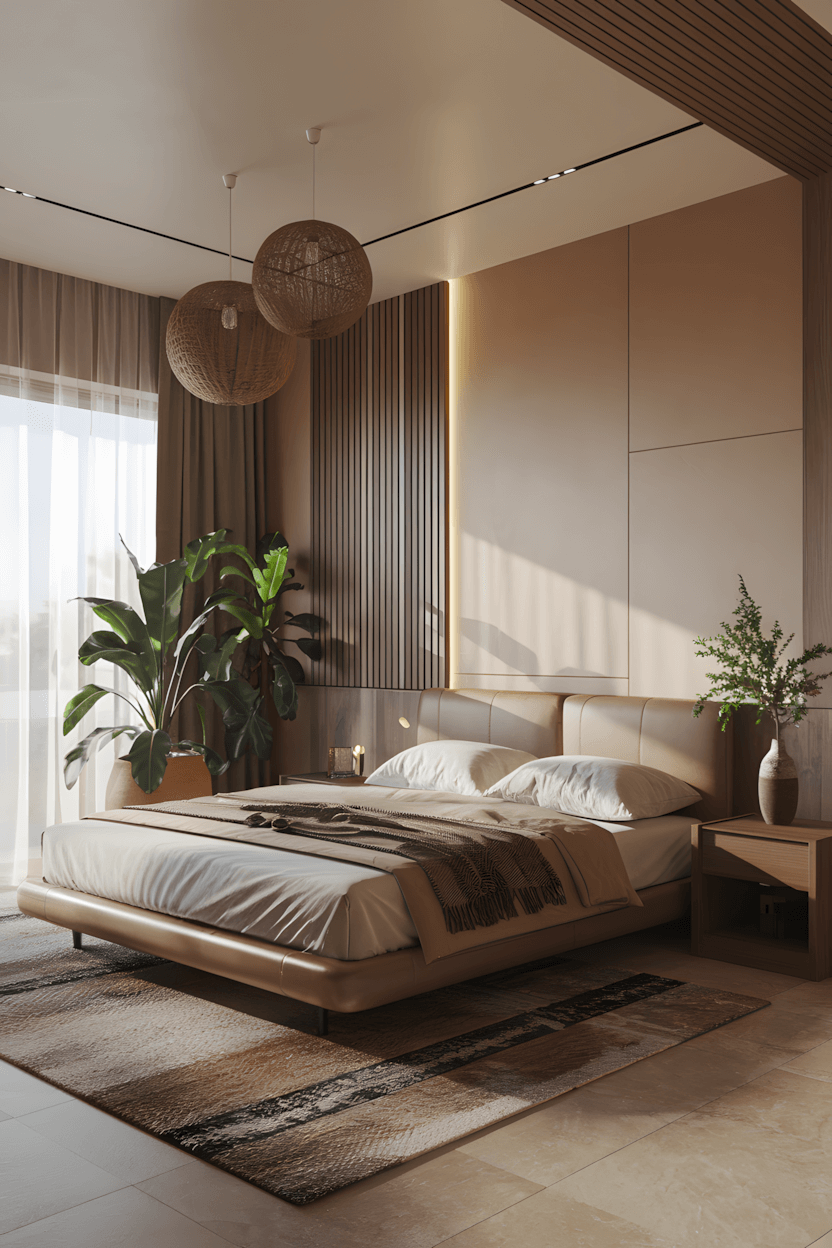
This nature-focused approach shows how organic materials can enhance both aesthetics and sleep quality.
Key Sleep-Supportive Elements:
- Wood paneling for natural warmth – provides authentic material connection that supports psychological well-being
- Woven lighting for organic texture – uses natural materials that avoid synthetic chemical exposure
- Plant integration for air purification – improves bedroom air quality essential for quality sleep
- Neutral tones for visual rest – maintains calming color palette that supports relaxation
Organic benefits: Natural materials typically off-gas fewer chemicals, supporting better air quality for sleep.
Rustic and Natural Integration
13. Live-Edge Modern Rustic
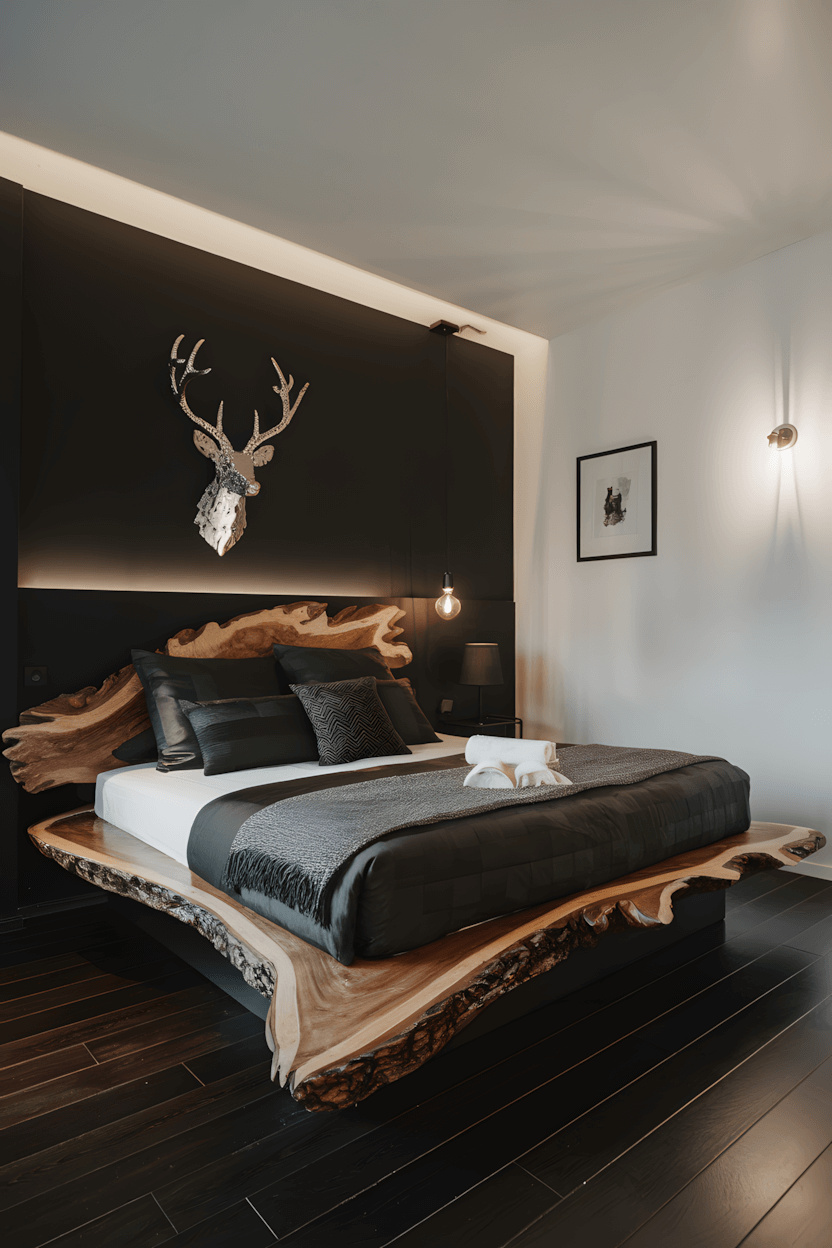
This authentic material approach demonstrates how natural wood elements can create unique character while supporting rest.
Key Sleep-Supportive Elements:
- Live-edge bed frame for natural authenticity – provides unique natural beauty while using chemical-free materials
- Dark walls for sleep-conducive environment – creates naturally dark atmosphere that supports quality sleep
- Hanging bulb lighting for adjustable ambiance – provides flexible lighting that can be dimmed for sleep preparation
- Textured bedding for tactile comfort – adds sensory satisfaction that supports relaxation
Natural authenticity: Live-edge wood provides unique character while maintaining the chemical-free benefits of natural materials.
14. Warm Neutral Comfort Focus
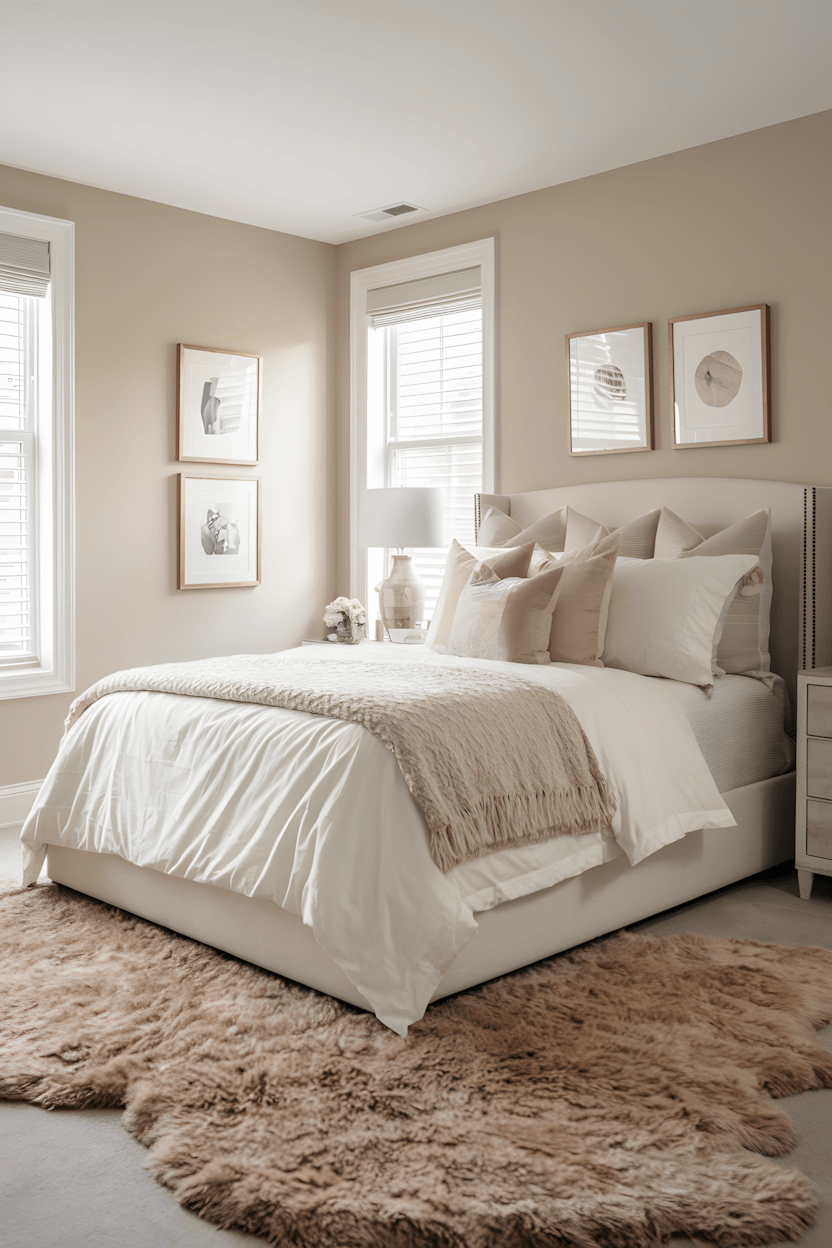
This comfort-centered approach shows how neutral palettes can create restful environments without being bland.
Key Sleep-Supportive Elements:
- Plush textures for physical comfort – provides tactile satisfaction that supports relaxation and stress reduction
- Warm lighting for evening ambiance – creates gentle illumination that doesn’t interfere with natural sleep preparation
- Artwork for personality without overstimulation – adds individual character while maintaining visual calm
- Soft materials for acoustic comfort – reduces noise that can interfere with sleep quality
Comfort prioritization: Physical comfort directly impacts sleep quality and should be the primary consideration in bedroom design.
Luxury and Premium Elements
15. Coffered Ceiling Luxury
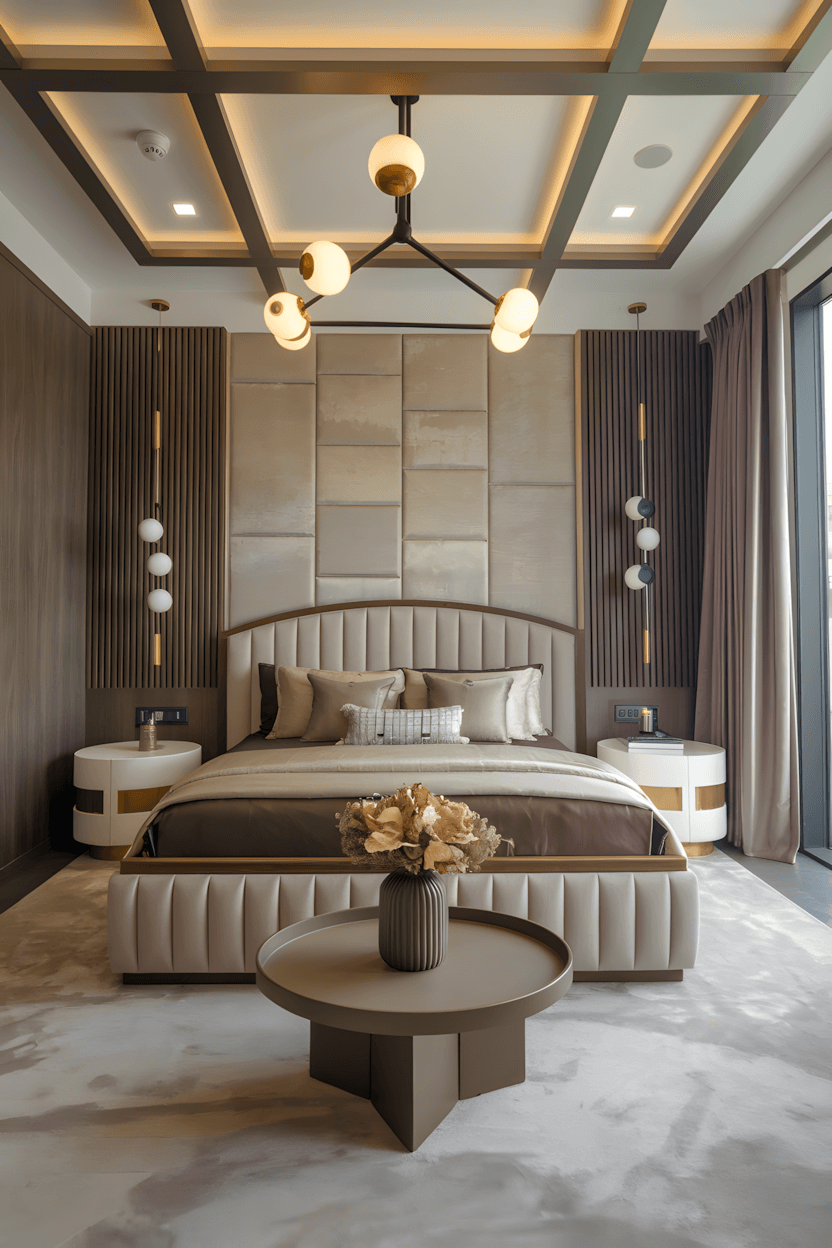
This architectural approach demonstrates how structural elements can enhance both beauty and sleep quality.
Key Sleep-Supportive Elements:
- Coffered ceiling for acoustic benefits – reduces noise while adding architectural interest
- Recessed lighting for even illumination – provides shadow-free lighting that can be dimmed for sleep preparation
- Quality bedding for temperature regulation – invests in materials that support comfortable sleep temperature
- Sophisticated finishes for long-term satisfaction – uses materials that provide lasting beauty and function
Architectural luxury: Quality construction often provides better acoustic and lighting control essential for sleep.
16. Circular Art with Natural Balance
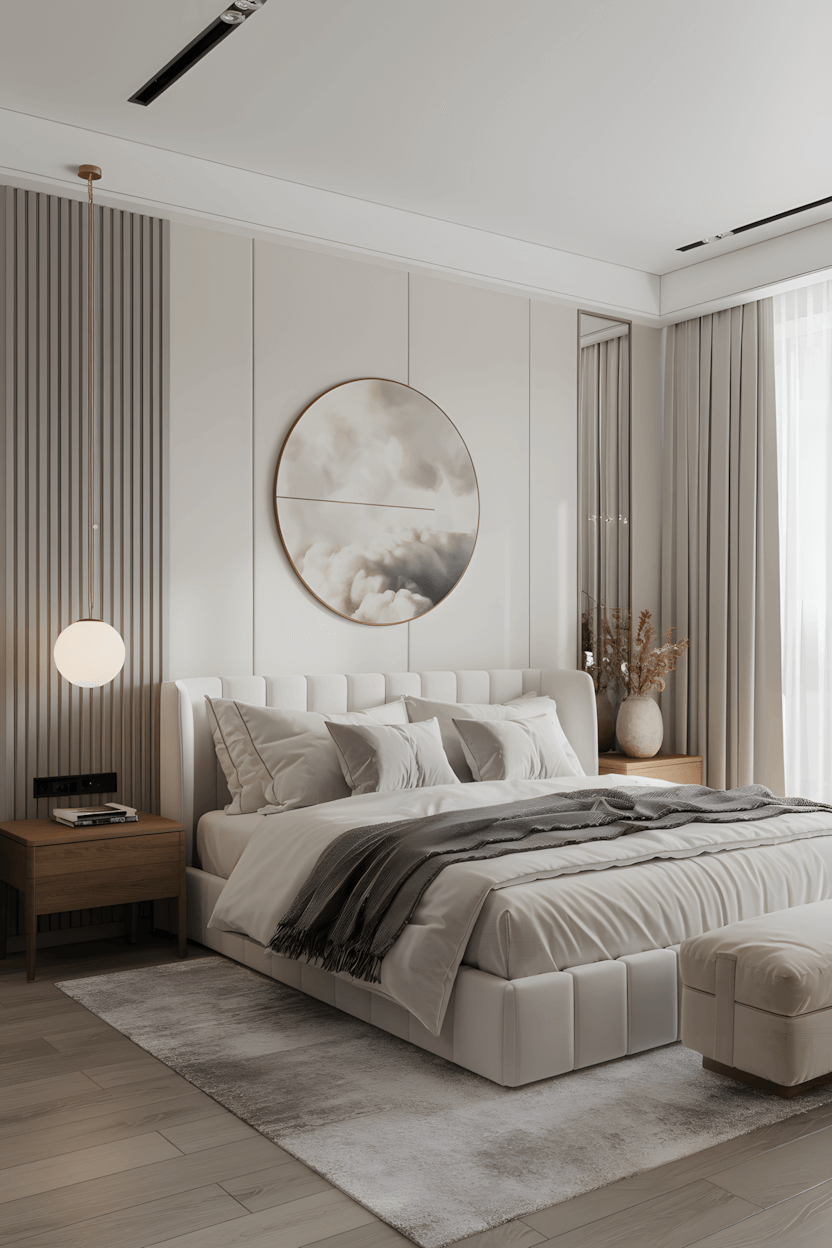
This artistic approach shows how art can enhance bedroom tranquility when chosen thoughtfully.
Key Sleep-Supportive Elements:
- Circular artwork for visual harmony – uses gentle shapes that promote psychological calm
- Light gray curtains for privacy and light control – provides essential darkness for sleep while maintaining daytime brightness
- Vertical wood panels for natural warmth – adds organic texture without overwhelming the space
- Balanced composition for visual rest – creates harmonious environment that supports relaxation
Art psychology: Gentle, organic shapes in artwork support relaxation better than angular or aggressive imagery.
Feminine and Soft Approaches
17. Floral Serenity with Natural Elements
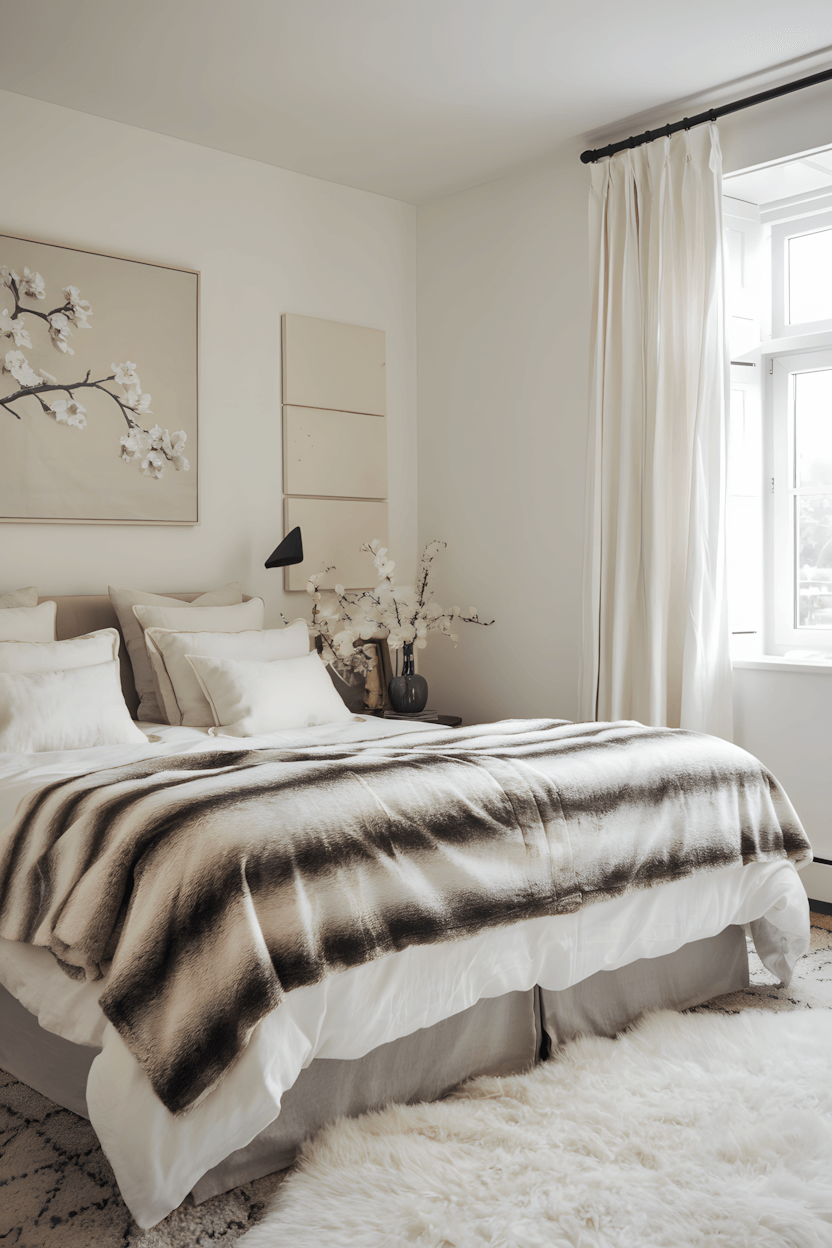
This nature-inspired approach demonstrates how floral elements can create calming environments.
Key Sleep-Supportive Elements:
- White blossom artwork for nature connection – incorporates calming natural imagery that supports stress reduction
- Soft textures for tactile comfort – provides sensory satisfaction that promotes relaxation
- Neutral palette for visual calm – maintains restful colors that don’t overstimulate before sleep
- Quality linens for sleep comfort – invests in materials that support temperature regulation and comfort
Floral psychology: Nature imagery, particularly flowers, has been shown to reduce stress and support relaxation.
18. Botanical Storage with Personality
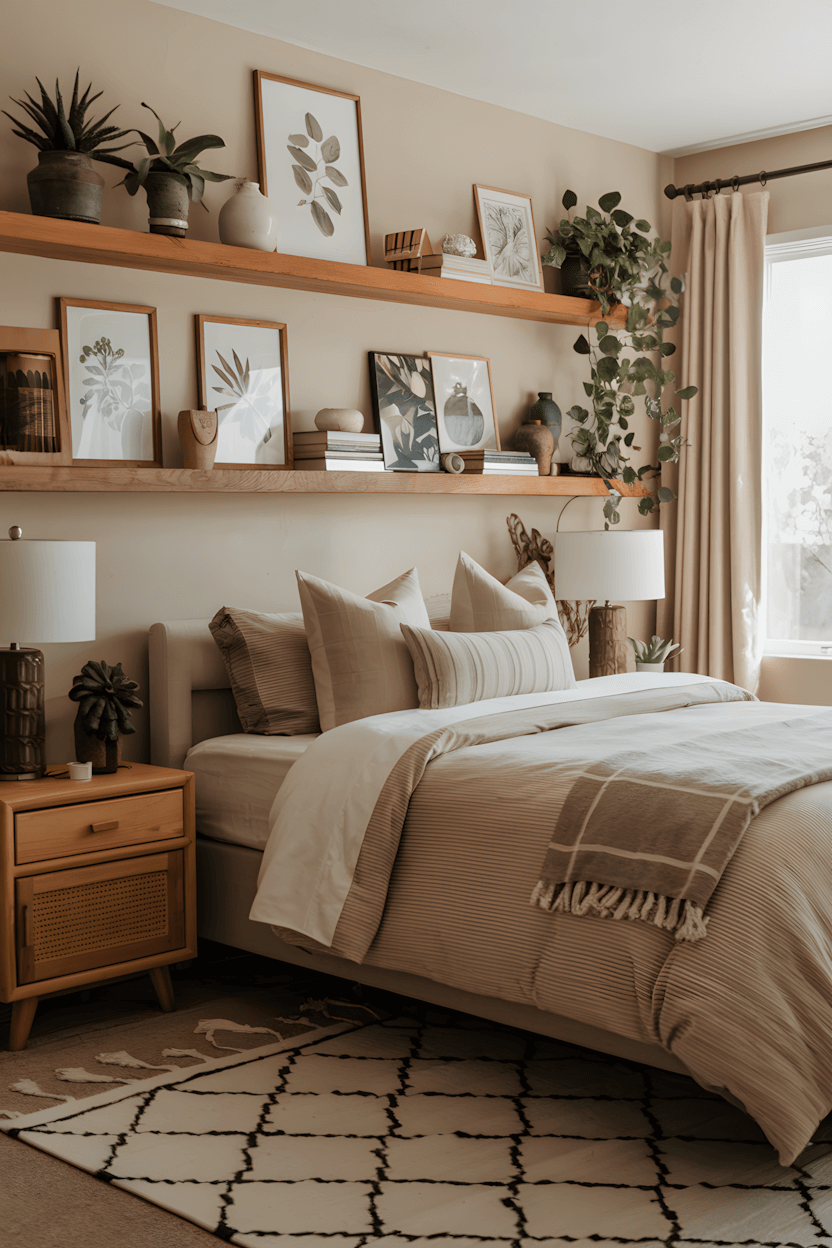
This organized approach shows how storage can enhance rather than compromise bedroom tranquility.
Key Sleep-Supportive Elements:
- Organized shelving for mental calm – reduces visual clutter that can interfere with relaxation
- Botanical elements for nature connection – incorporates plants and plant imagery that support air quality and stress reduction
- Books for bedtime routine support – provides accessible reading materials that support healthy sleep routines
- Natural materials for chemical-free environment – uses wood and plants to improve air quality
Organization benefits: Organized bedrooms support better sleep by reducing stress and creating calm environments.
Bold Color with Comfort Balance
19. Dark Green with Warm Accents
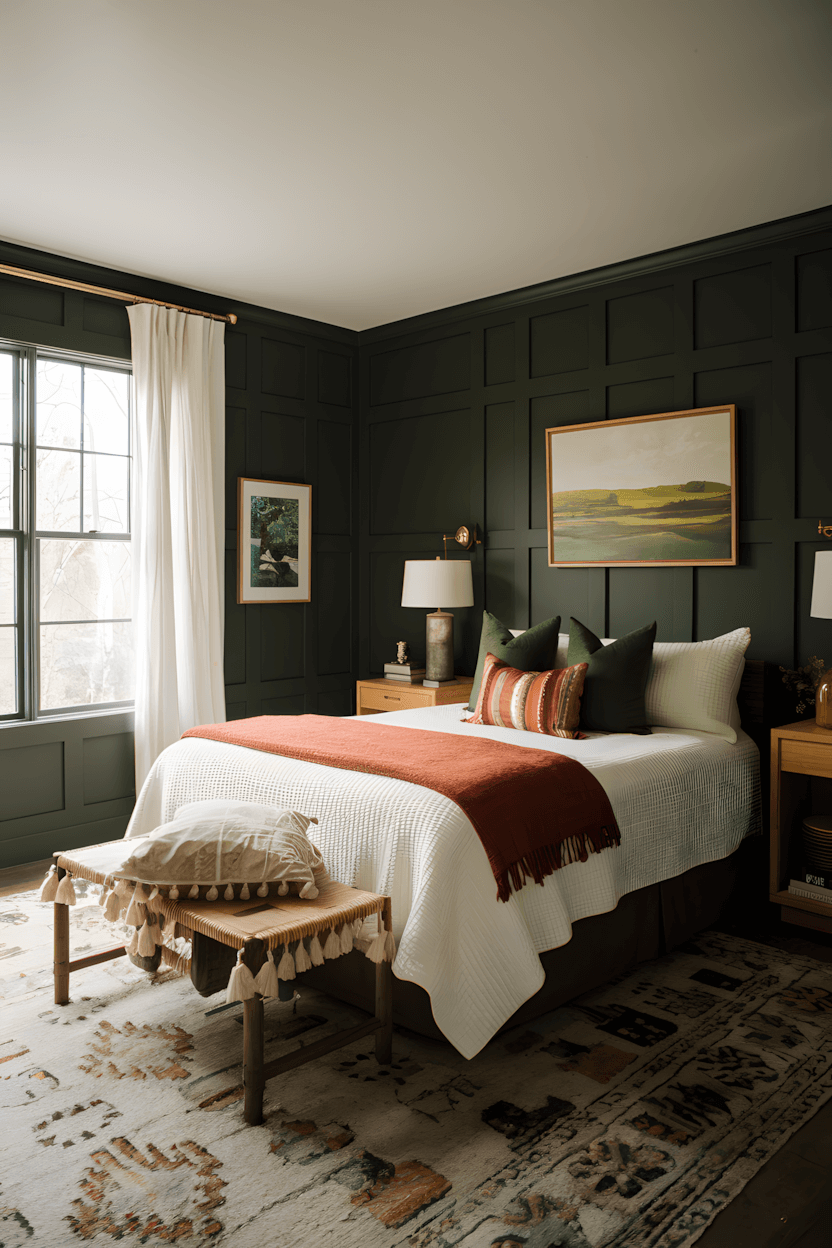
This dramatic approach demonstrates how bold colors can create cozy rather than stimulating environments.
Key Sleep-Supportive Elements:
- Dark green walls for cocoon-like comfort – creates enveloping environment that supports feelings of security
- White bedding for contrast and freshness – provides clean, bright bedding while maintaining restful wall color
- Rust accents for warmth – adds earth-tone comfort without overstimulation
- Wooden bench for natural texture – incorporates organic materials that support well-being
Bold color strategy: Dark, rich colors can enhance sleep quality by creating naturally darker, more secure-feeling environments.
20. Gray with Feminine Touches
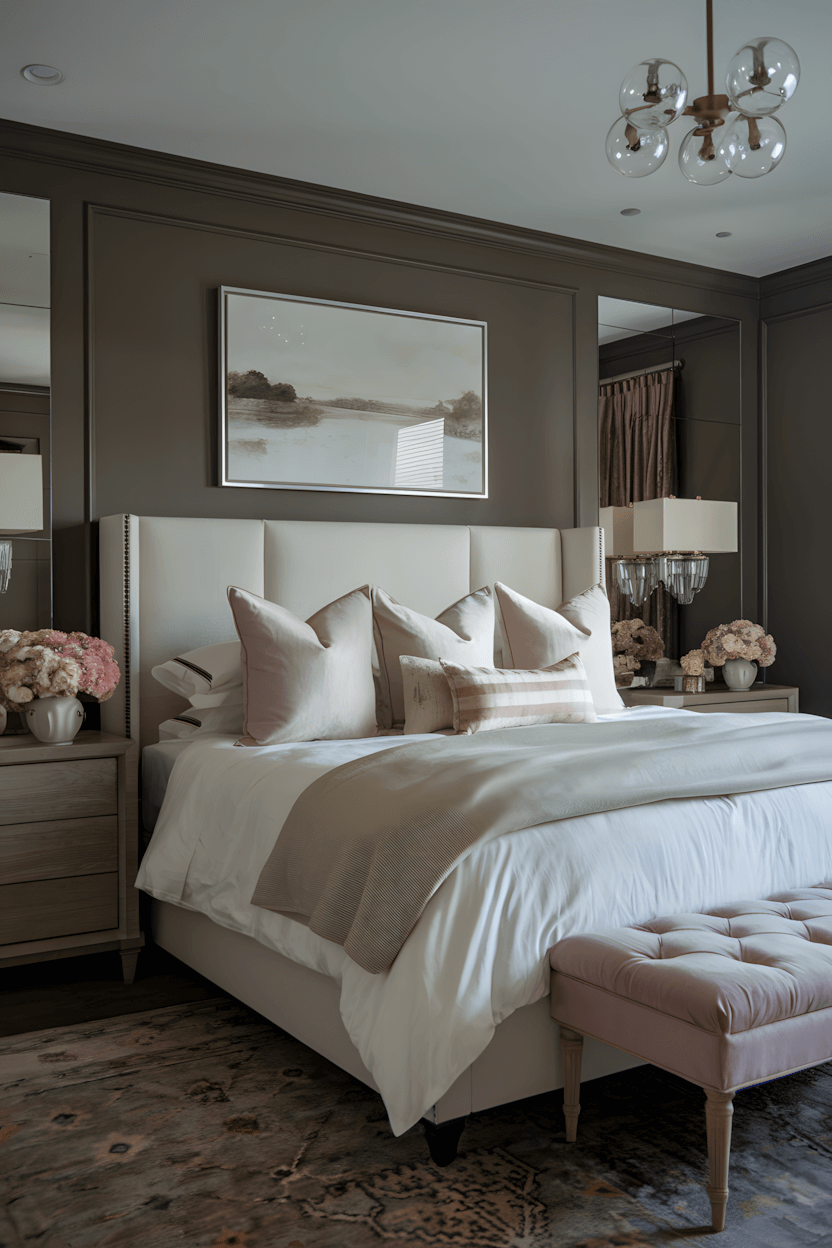
This balanced approach shows how to incorporate personality while maintaining sleep-supportive neutrality.
Key Sleep-Supportive Elements:
- Muted gray walls for sophisticated calm – provides neutral backdrop that supports relaxation without being stark
- Soft pink accents for warmth – adds gentle color that doesn’t overstimulate
- Crystal chandelier for elegant lighting – provides beautiful illumination that can be dimmed for sleep preparation
- Balanced color palette for visual rest – maintains calming proportions that support mental relaxation
Color balance: Successful bedroom color schemes prioritize calm over excitement while maintaining personality.
Sophisticated and Timeless Design
21. Botanical Elegance with Quality Materials
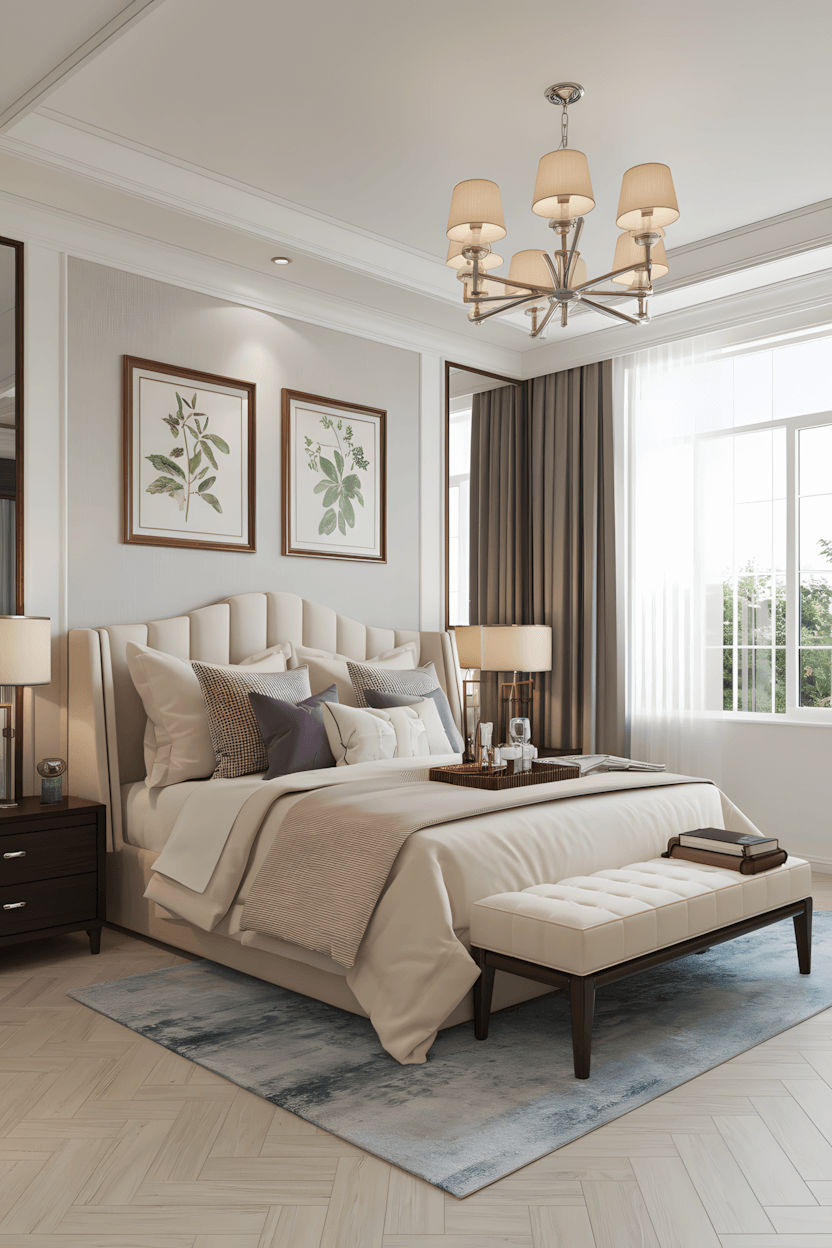
This refined approach demonstrates how elegance can support rather than compromise rest and relaxation.
Key Sleep-Supportive Elements:
- Quality bedding for sleep comfort – invests in materials that provide temperature regulation and lasting comfort
- Botanical prints for nature connection – incorporates calming natural imagery that supports stress reduction
- Multiple light sources for flexibility – provides lighting options that support various activities and sleep preparation
- Sophisticated materials for long-term satisfaction – uses finishes that provide lasting beauty and function
Timeless elegance: Classic design elements often provide better long-term satisfaction than trendy alternatives.
22. Urban Views with Light Management
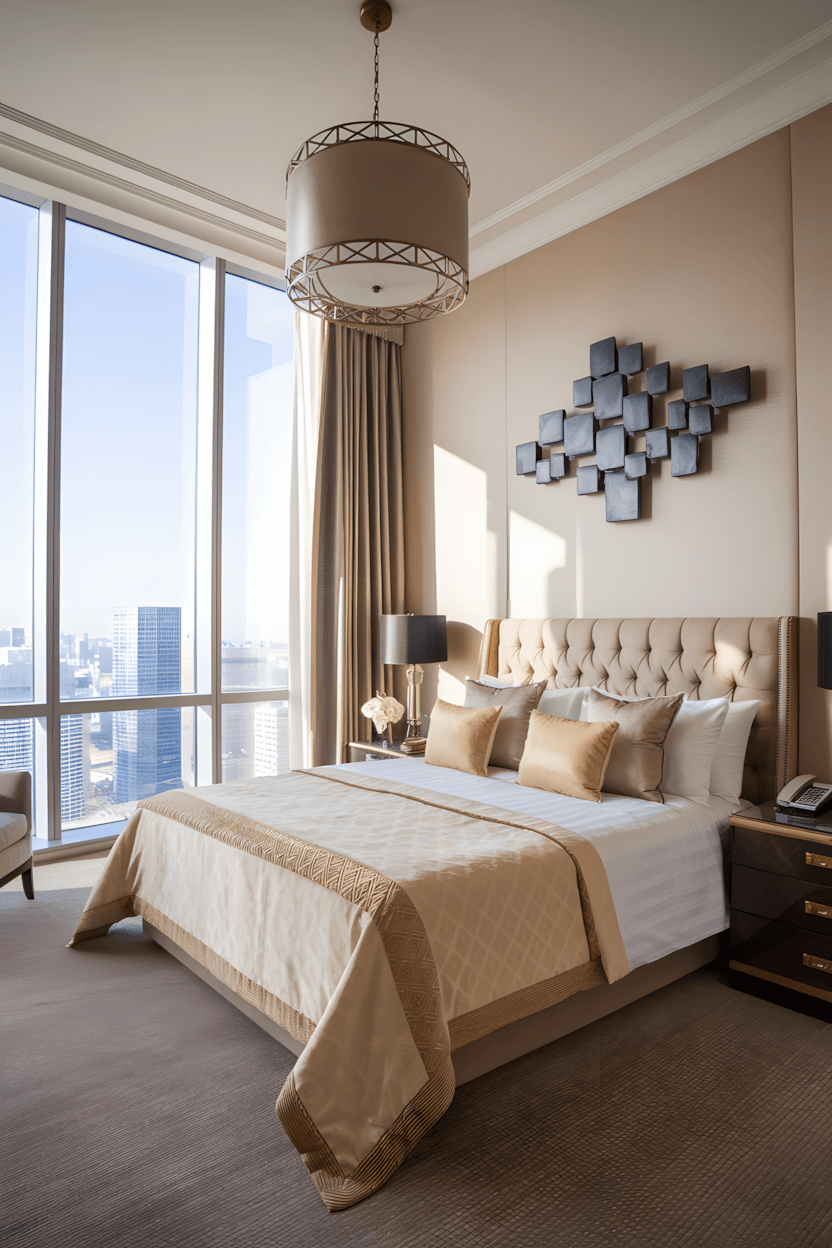
This city-focused approach shows how to balance spectacular views with sleep-quality considerations.
Key Sleep-Supportive Elements:
- Floor-to-ceiling windows with light control – maximizes views while providing essential darkness for sleep
- Tufted headboard for reading comfort – provides proper support for bedtime reading routines
- Geometric art for sophisticated interest – adds visual appeal without overstimulation
- Quality materials for urban durability – uses finishes that withstand city environmental challenges
Urban sleep challenges: City bedrooms require careful attention to light and noise control despite beautiful views.
23. Soft Pink Comfort Environment
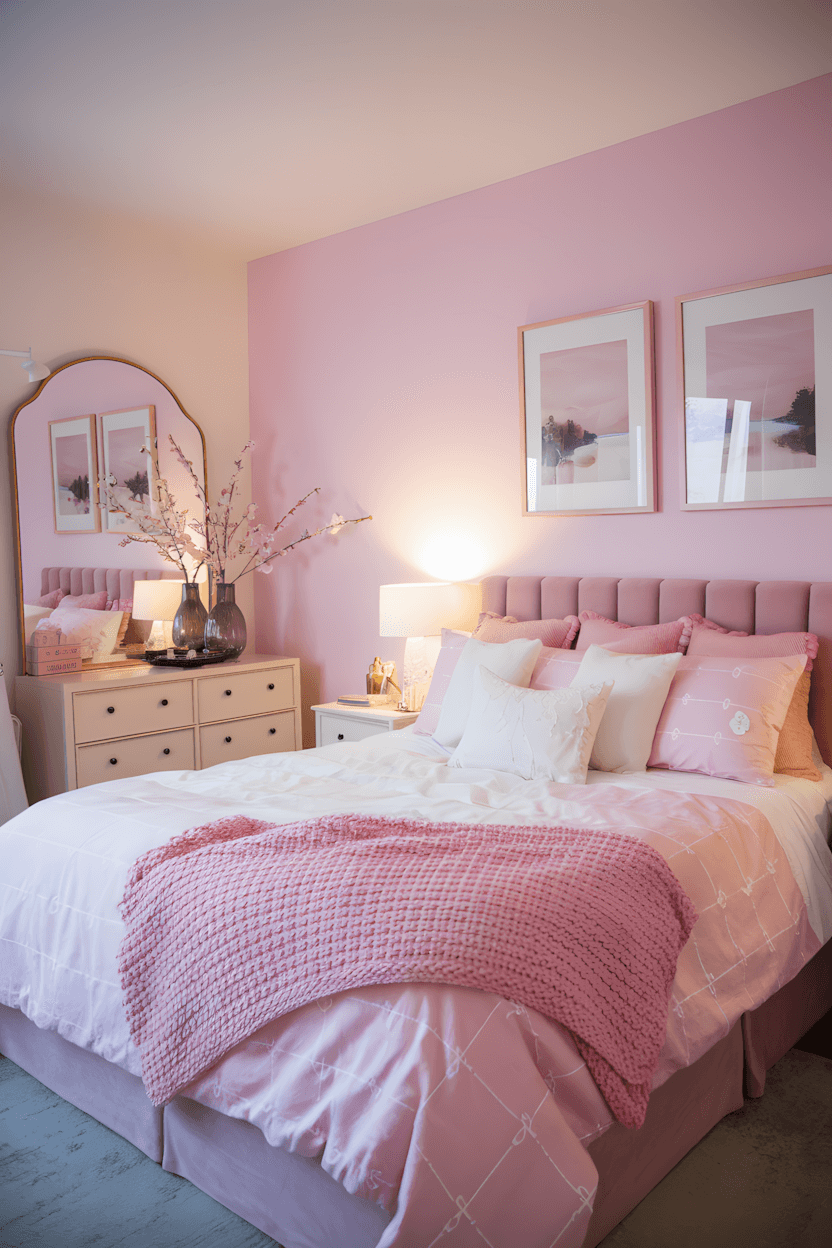
This gentle approach demonstrates how soft colors can create nurturing sleep environments.
Key Sleep-Supportive Elements:
- Pink and white palette for psychological comfort – uses gentle colors that promote feelings of safety and calm
- Knitted textures for tactile comfort – provides sensory satisfaction that supports relaxation
- Floral artwork for nature connection – incorporates calming natural elements
- Soft ambient lighting for evening relaxation – creates gentle illumination that supports sleep preparation
Gentle color psychology: Soft, warm colors support relaxation and stress reduction essential for quality sleep.
24. Geometric Modern with Comfort Focus
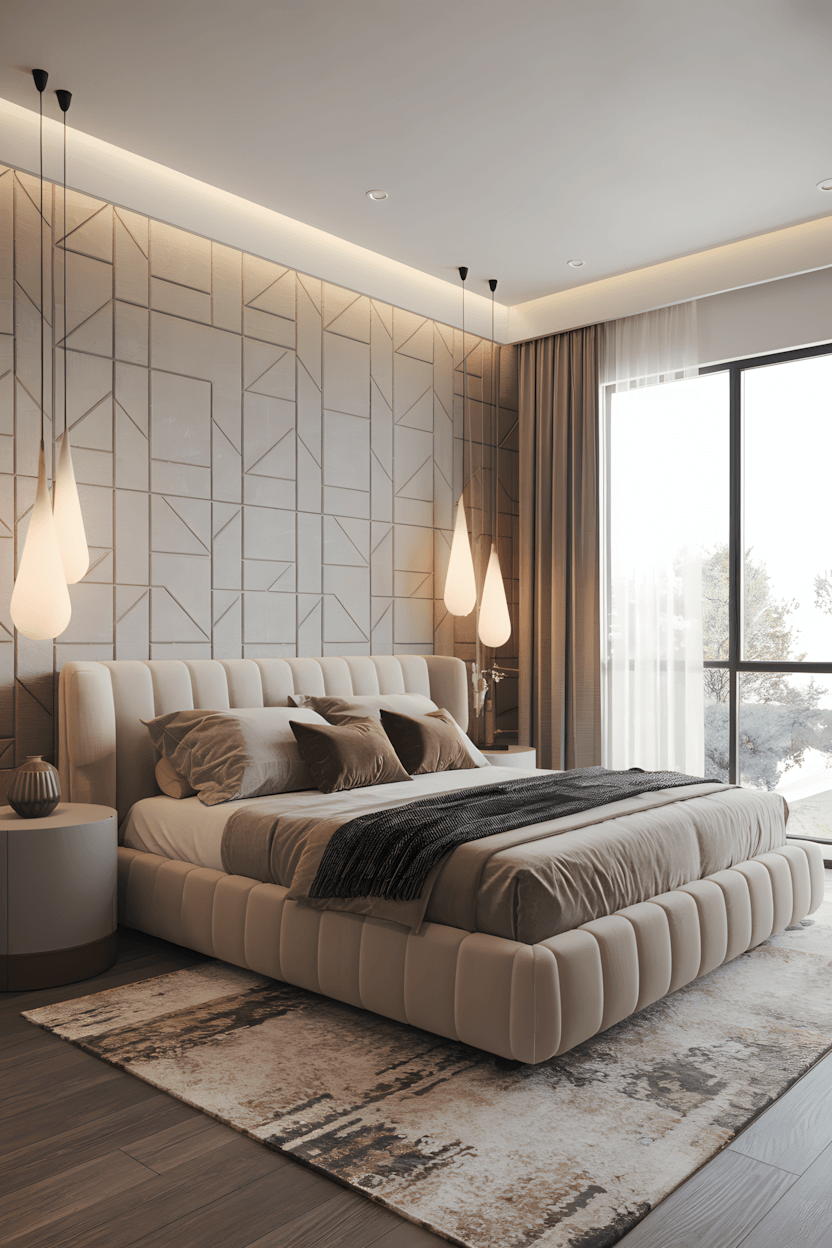
This contemporary approach shows how modern design can prioritize comfort and sleep quality.
Key Sleep-Supportive Elements:
- Textured geometric wall for visual interest – provides pattern that’s engaging but not overstimulating
- Teardrop lighting for unique ambiance – offers interesting illumination that can be adjusted for sleep preparation
- Plush upholstered bed for comfort – prioritizes physical comfort essential for quality sleep
- Contemporary materials for easy maintenance – uses finishes that support cleanliness important for sleep hygiene
Modern comfort: Contemporary design can successfully prioritize comfort when sleep quality is the primary consideration.
25. Muted Elegance with Natural Integration
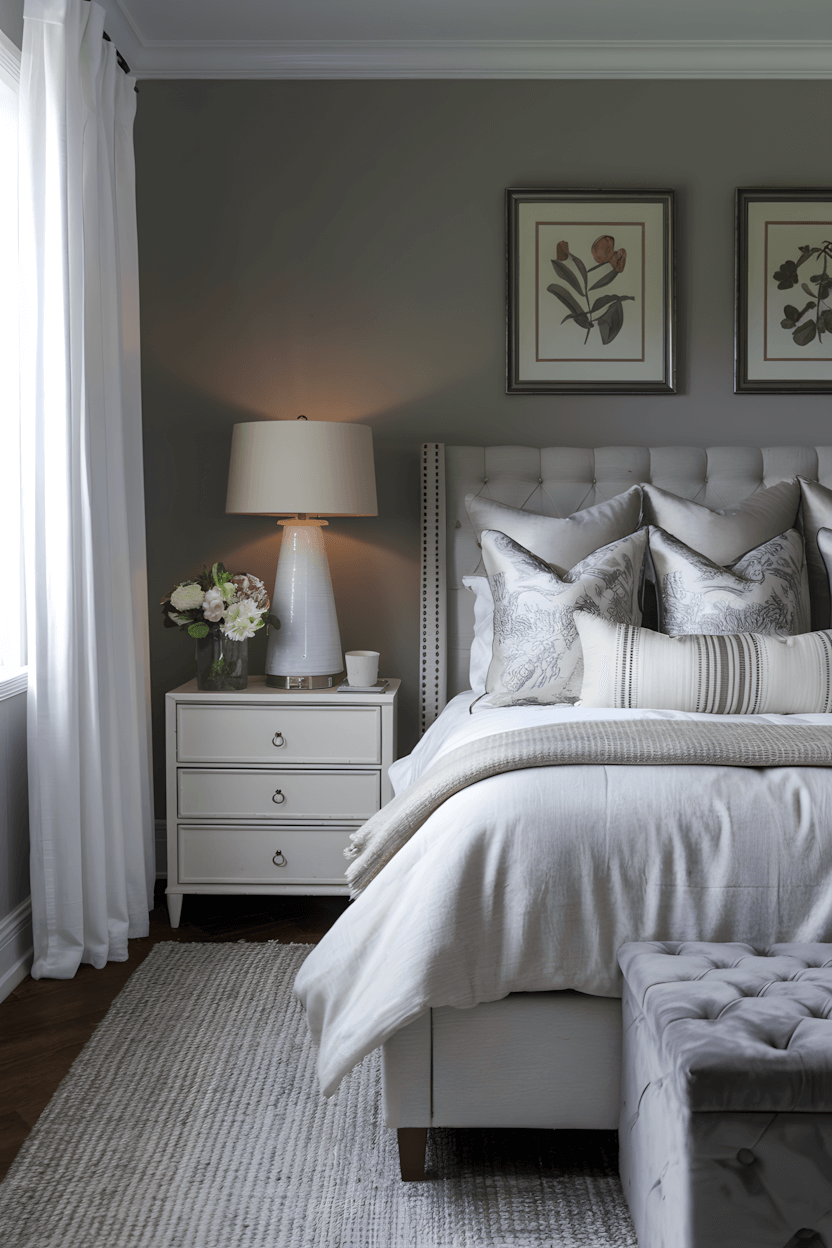
This final approach demonstrates how to create sophisticated environments that genuinely support rest and well-being.
Key Sleep-Supportive Elements:
- Muted gray palette for sophisticated calm – provides elegant foundation that supports relaxation
- Botanical artwork for stress reduction – incorporates nature imagery that psychologically supports well-being
- Tufted ottoman for comfort functionality – provides seating that supports bedtime routines
- Quality materials for lasting satisfaction – invests in finishes that provide long-term beauty and function
Sophisticated rest: True bedroom elegance prioritizes comfort and sleep quality over purely aesthetic considerations.
Creating Sleep-Supportive Bedroom Sanctuaries
After years of bedroom design projects, I’ve learned that successful bedrooms balance three essential considerations: sleep science principles that genuinely support rest and recovery, aesthetic appeal that enhances daily well-being and personal satisfaction, and practical functionality that accommodates real bedtime routines and maintenance needs.
The bedrooms that homeowners love long-term are those that solve real sleep challenges—darkness for quality rest, comfortable temperature regulation, reduced stress and overstimulation, organized storage for bedtime routines—while reflecting personal style and creating environments that genuinely support daily well-being.
Focus on understanding how design choices actually impact sleep quality rather than following trends that may compromise rest.
Most importantly, consider your actual sleep patterns, comfort preferences, and bedroom activities when making design decisions.
The most beautiful bedroom means nothing if it doesn’t support the quality sleep that’s essential for health, well-being, and daily life satisfaction.
Which of these sleep-supportive approaches matches your rest needs, comfort preferences, and vision for bedroom sanctuary?

